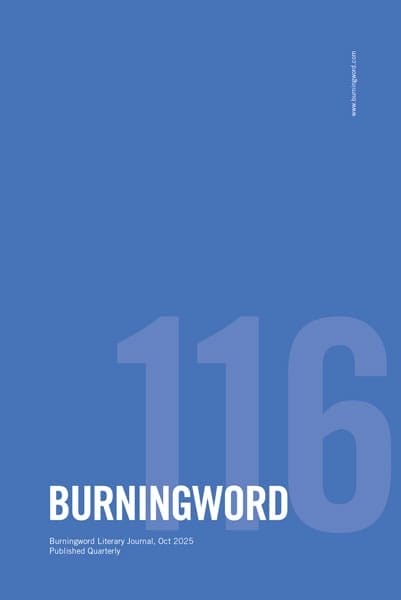April 2024 | poetry
Humming like a subterranean network sized computer is a fear
that if I ever meet my creator, They will not resemble me –
only appear as an abstract painting, less resolution than myself
and I will look at Them, and They, unthinkingly will stare through me
and, I will find myself to be the one more alive. Our virtual creations
won’t make me question if their bytes are analogous to my experiences.
Those perfect, idealized pixels will remain dead. Then,
I will have to keep living, having extravagant celebrations,
quadruple tiered wedding cakes, bouquets of tulips,
chocolate rabbits. Which is all to say, great tragedies can be a moment.
Elias Diakolios holds an MFA in poetry from Columbia University where he served as Poetry Editor for Columbia Journal 59. His work has been nominated for a Pushcart Prize and has appeared in New Notes Poetry, Pidgeonholes, Epiphany Magazine, Bookends Review, Juked, and others. Currently, he teaches in the Writing Department at Montclair State University and works on linocuts in his spare time.
Elias Diakolios
April 2024 | fiction
You’ll never guess what I just found. Ann steps over the pile of boxes blocking the doorway, a small black object in her hand. Haven’t seen one of these in years.
She hands it over. An old floppy disc.
Bloody hell, me neither. Where was it?
Found it unpacking a box of your old college stuff. Any idea what’s on it?
Not sure. He turns it over. There’s a crack in one corner, and an illegible red scribble on the label. Chloe Hide’s handwriting. Oh.
The class was paired into teams. He and Chloe were put together. For the whole afternoon she sat beside him, shoulders bare in the muggy heat, red ponytail down her back. When she stretched her arms over her head, he craned forwards to peek at her breasts, turning away as she relaxed, afraid she’d catch him staring. They talked and he made her laugh. At the end of the lesson, they saved their work on a disc and he promised to look after it. Outside, the wind tossed her hair over her shoulder, the clear sky glinted in her eyes. Ask if she wants to go get a cup of tea, or something to eat maybe. Just ask her.
OK, great. See you tomorrow. Her smile showed her braces.
He watched her turn the corner, then ran the other way for the bus. Chloe walked home alone. The police recovered her two weeks later.
He strokes his thumb across the red ink. It doesn’t smudge. It dried decades ago.
It’s nothing. Just some old college junk.
I’ll throw it out then if you want. Can’t use it for anything. Ann holds out her hand.
No. It’s fine.
Ann shrugs and goes back upstairs. He sits down, and slides the disc into his pocket.
Sam comes from East Yorkshire but now resides in Lancashire. He recently completed a Masters in Creative Writing at Lancaster University, and has had two books published, one in 2020 by Alban Lake, and the other in 2018 after it won 1st Prize in the National Association of Writers’ Group’s 2017 novella competition. When not writing, he likes cooking, hiking, and spending time with his fiancé and his cat.
Sam Graham
April 2024 | Best of Net nominee, nonfiction
The barrio adjacent to the state’s only Catholic university held Grandma’s ChaCha yellow house became a hub for elaborate yard sales. With the sun shining year-round, children would take barefoot to the rows of front yards down the block. The parents wrangled their kids to visit our yard sale in hopes of finding a new sweater for the coming school year or a pair of smudged Converse knock-offs.
I was too little to be of any real help to my mom, grandma, and Aunt Sugar who meticulously planned every aspect of each yard sale. “The cord needs to wrap around the tree tighter to hang the clothes.” “Put the toys in this box.” “Stack the books over on this table.”
While they set everything up, the radio blasted KOOL 60s Oldies. I loved to twirl under the shirts hanging from the clothesline and pretend that my dad’s old button-up was my dance partner. My cousin interrupted my fantasy and squirted me with a super soaker. We chased each other in between Spanish-speaking customers. I could hear Aunt Sugar and my mom yelling at us to stop. We didn’t stop. We ran carefree, not understanding that one day this memory would cause a longing to be that barrio child again.
Sarah Chavera Edwards is a Mexican American writer based in Phoenix. She is both a professional freelance writer and creative writer. Her work has appeared in The Dewdrop, The Nasiona, The Roadrunner Review, and Terse Journal. Her creative nonfiction piece, “Mujeres Divinas/Divine Women,” was the winner of the 2021 Nonfiction Prize through The Roadrunner Review. The piece was then published in an anthology about life and death in 2023. Her subject matter deals with Latino issues, mental illness, and memoir.
Sarah Chavera Edwards
April 2024 | fiction
The concert hall took a direct hit during the first week the city was shelled. Sandbags piled alongside the walls protected the stained glass windows of the former church, but the roof was punctured and the interior set ablaze. With rockets landing in the quarter and water mains shattered, the fire burned unabated. When the fighting ended days later, crews began to sift through debris. Combing through the ashes, broken plaster, and fallen brickwork, the orchestra conductor located the thick bound volumes of old concert programs. He dusted them off, smiling to himself. Their history had been saved. The roof and rows of charred seats could be replaced. Fortunately, most of the musicians had taken their valuable instruments home with them. Digging deeper, he found stacks of music stands, ash-covered but intact. Beneath them, though singed and water-stained, sheets of music for the Friday concert were still legible.
Looking at the soiled pages, a thought came to him. Three violinists lived within walking distance. If they were home, if they had their instruments, and if he could contact them, they might be able to play. The orchestra had not canceled a performance in forty-eight years. As conductor, he had never missed a concert. It would be a haphazard orchestra for a haphazard audience. A few violins would barely be heard over the distant explosions, sirens, and the barking of stray dogs. But they could perform, their history maintained.
That late afternoon, with snow falling, two men and a woman in overcoats, played the Brahms violin concerto on the steps of the shattered concert hall. A half-dozen shivering rescue workers clustered around a small fire listened, some closing their eyes. A pair of reporters recorded the orchestra with their cell phones, broadcasting the performance to the refugees, the fighters, the relief workers, the traumatized, and the bedridden of Kiev.
Mark Connelly’s fiction has appeared in Indiana Review, Milwaukee Magazine, Cream City Review, The Ledge, Smoky Blue Arts and Literary Magazine, Change Seven, Light and Dark, 34th Parallel, The Chamber Magazine, Mobius Blvd., and Digital Papercut. In 2005 Texas Review Press published his novella Fifteen Minutes, which received the Clay Reynolds Prize. His most recent short story “That Forgotten Monday” appeared in The Chamber Magazine in October 2023 and was published in Möbius Blvd in December.
Mark Connelly
April 2024 | nonfiction
No one within hearing badmouthed the new town’s two ceramic frogs perched columnar on oxidized blue lily pads outside City Hall like they never did on Crenshaw Pond.
*
Sheriff Osprey couldn’t find or explain the missing pair of rattlesnake skin cowboy boots enshrined in glass once worn by Riddly Tucson, founder and first mayor of Burlington West.
*
The story told more often in schools, saloons, and after-church lawn gatherings had to be Roy Calhoun’s losing his battle with the bottle blamed for heaving him and his horse into Red Pine Canyon, Chester saved when hung up forty feet above the canyon floor by its titular tree, his rider not so lucky, pitched headfirst on a boulder the size of Paul Bunyan’s bowling ball.
*
The last to leave the deserted town, Pastor Wiggins, preached a sermon to a congregation of ants, mice, rats, and bats, advising them to learn the lesson God gave Job, to pay obeisance to the Lord no matter how stark their futures, without hope or food.
*
The developer stressed the new primitive, box over box, the way of the future born from the county’s Indigenous past for maximum efficiency, aesthetic nuance, and ambient preservation like no other in-town rural casual formal feel.
*
“Pond? What pond?” Mrs. Killibrew threw at the half-blind, nearly-deaf Claude Wiggins, her frosted flute meant for more than grocery store Chablis half empty, then lifted from her hand-me-down Brown Jordan chaise to emphasize her gift for leaving idiots to stir themselves thick.
*
When the residents of Cactus Butte Luxury Homes opened their manilla envelopes on Thursday, May 14, 2042, they might have felt a similar sinking feeling as Roy Calhoun when first pitched off the trail, Chester dropping beneath him as if he’d taken up flying, long-needled pine boughs slapping his face bringing him to an unwanted and unplanned consciousness until, upended, landing as he knew he must, the split second crack hatching a split-second memory of the Cowtown Rattlesnake Round Toe boots, squirming out of a coil as he liked to think of them, under three loosened floorboards in Pastor Wiggins’s horse barn over which Sheriff Osprey every day clomped like a man with little or no horse sense before everything went dark.
Richard Holinger’s work has appeared in Chicago Quarterly Review, Hobart, Iowa Review, Chautauqua, and has garnered four Pushcart Prize nominations. Books include North of Crivitz (poetry) and Kangaroo Rabbits and Galvanized Fences (essays). He holds a doctorate in Creative Writing from UIC, has taught English and creative writing on several levels, and lives northwest of Chicago overlooking Lake Campton.
Richard Holinger


